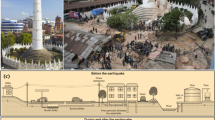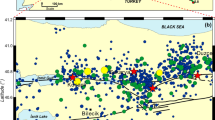Abstract
Earthquakes often cause significant human loss and infrastructural damage. Infrastructural losses can be minimized through adopting efficient earthquake-resistant design considering dynamic soil–structure interaction (DSSI) effects. The DSSI can be dealt only upon realizing the response of soils to dynamic loads. Nonlinear ground response analysis (GRA) complemented with liquefaction phenomenon helps in understanding the soil response to varying dynamic loads. This article discusses the critical findings of soil response subjected to different seismic ground motions for typical soil profiles of Assam, one of the most active seismic regions of India. The one-dimensional (1D) nonlinear effective stress-based GRA was conducted using the experimentally derived site-specific dynamic soil properties and artificially generated seismic ground motions. Results obtained from the study are used to assess the critical aspects of nonlinear soil behavior in terms of acceleration amplifications, pore pressure buildup and large deformation-related stress–strain response. It is concluded from this study that the loose or soft soil deposits from this region are expected to amplify the incoming seismic waves. In contrary, high-intensity seismic motions are leading to attenuation of seismic waves and inducing higher soil displacements and liquefaction traces. With the frequent occurrence of mild to moderate seismic events and with a possibility of intense seismic event in the near future for the region, results from this study will be helpful for design engineers targeting earthquake resistant design of new infrastructure or requalification studies of existing major infrastructure.

























Similar content being viewed by others
References
IS:1893 (2002) Criteria for Earthquake Resistant Design of Structures. Indian Stand 1–44
Kayal JR, De R (1991) Microseismicity and tectonics in northeast India. Bull Seismol Soc Am 81:131–138
Oldham R (1899) Report of the great earthquake of 12 June 1897. Mem Geol Surv India 29:1–379
Poddar M (1950) The Assam earthquake of 15th August 1950. Indian Mineral 4
Guha S, Bhattacharya U (1984) Studies on prediction of seismicity in northeastern India. In: 8th world conference on earthquake engineering. San Francisco
Khattri KN (1999) Probabilities of occurrence of great earthquakes in the Himalaya. Proc Indian Acad Sci Earth Planet Sci 108:87–92
Dammala PK, Bhattacharya S, Krishna AM et al (2017) Scenario based seismic re-qualification of caisson supported major bridges: a case study of Saraighat Bridge. Soil Dyn Earthq Eng 100:270–275. https://doi.org/10.1016/j.soildyn.2017.06.005
Raghu Kanth STG, Dash SK (2010) Evaluation of seismic soil-liquefaction at Guwahati city. Environ Earth Sci 61:355–368. https://doi.org/10.1007/s12665-009-0347-3
Ordóñez GA (2004) SHAKE2000 for the 1-D analysis of geotechnical earthquake engineering problems User ’ s Manual. 1–266
Park D, Hashash YMA (2008) Rate-dependent soil behavior in seismic site response analysis. Can Geotech J 45:454–469. https://doi.org/10.1139/T07-090
Raghu Kanth STG, Sreelatha S, Dash SK (2008) Ground motion estimation at Guwahati city for an Mw 8.1 earthquake in the Shillong plateau. Tectonophysics 448:98–114. https://doi.org/10.1016/j.tecto.2007.11.028
Kumar SS, Krishna AM (2013) Seismic ground response analysis of some typical sites of Guwahati City. Int J Geotech Earthq Eng 4:83–101. https://doi.org/10.4018/jgee.2013010106
Dammala PK, Krishna AM, Bhattacharya S et al (2017) Dynamic soil properties for seismic ground response studies in Northeastern India. Soil Dyn Earthq Eng 100:357–370. https://doi.org/10.1016/j.soildyn.2017.06.003
Kumar SS, Adapa MK, Dey A (2018) Importance of site-specific dynamic soil properties for seismic ground response studies. Int J Geotech Earthq Eng In press
Baro O, Kumar A, Ismail-Zadeh A (2018) Seismic hazard assessment of the Shillong plateau, India. Geomatics Nat Hazards Risk 9:841–861. https://doi.org/10.1080/19475705.2018.1494043
Pallav K, Raghukanth STG, Singh KD (2012) Probabilistic seismic hazard estimation of Manipur, India. J Geophys Eng 9:516–533. https://doi.org/10.1088/1742-2132/9/5/516
Pallav K, Raghukanth STG, Singh KD (2015) Estimation of seismic site coefficient and seismic Microzonation of Imphal City, India, using the probabilistic approach. Acta Geophys 63:1339–1367. https://doi.org/10.1515/acgeo-2015-0045
Sil A, Sitharam TG, Kolathayar S (2013) Probabilistic seismic hazard analysis of Tripura and Mizoram states. Nat Hazards 68:1089–1108. https://doi.org/10.1007/s11069-013-0678-y
Sitharam TG, Sil A (2014) Comprehensive seismic hazard assessment of Tripura and Mizoram states. J Earth Syst Sci 123:837–857. https://doi.org/10.1007/s12040-014-0438-8
Goud P, Reddy B, Madhira M (2020) ground response analysis of passighat airport and Moga Bridge Sites. In: Advances in geotechnical and transportation engineering. Singapore
Kumar CR, Kesiezie N, Singh N, Maiti S (2016) Seismic site response studies for microzonation and hazard assessment of Kohima, Nagaland, North Eastern Region of India. Indian J Geosci 71:501–518
Rao KS, Varun M, Thaker TP (2010) Ground response studies for the design of head race tunnel (HRT) of the Chuzachen Hydroelectric Project, Sikkim. In: Indian geotechnical conference. IIT Bombay
Garala TK, Madabhushi GSP (2019) Seismic behaviour of soft clay and its influence on the response of friction pile foundations. Bull Earthq Eng 17:1919–1939. https://doi.org/10.1007/s10518-018-0508-4
Hashash YM, Groholski DR (2010) Recent advances in non-linear site response analysis. In: Fifth international conference on recent advances in geotechnical earthquake engineering and soil dynamics symposium in honor of Professor IM Idriss 29:1–22. https://doi.org/10.1016/j.soildyn.2008.12.004
Basu D, Boga M, Dey A (2019) A time-domain nonlinear effective-stress non-Masing approach of ground response analysis of Guwahati city, India. Earthq Eng Eng Vib 18:61–75. https://doi.org/10.1007/s11803-019-0490-0
Dammala PK, Kumar SS, Krishna AM, Bhattacharya S (2019) Dynamic soil properties and liquefaction potential of northeast Indian soil for non-linear effective stress analysis. Bull Earthq Eng 17:2899–3293. https://doi.org/10.1007/s10518-019-00592-6
Grasso S, Maugeri M (2012) The seismic microzonation of the city of Catania (Italy) for the etna scenario earthquake (m = 6.2) of 20 february 1818. Earthq Spectra 28:573–594. https://doi.org/10.1193/1.4000013
Seed HB, Idriss IM (1970) Soil moduli and damping factors for dynamic response analysis
Vucetic M, Dobry R (1991) Shear strain 7 for the first cycle of unidirectional cyclic shear loading. The relation consists of the initial loading curve OD, the unloading branch of the loop DEC, and the reloading branch CFD. The loop in Fig. 1 (a) is somewhat idealized in th. J Geotech Eng 117:89–107
Darendeli M (2001) Development of a new family of normalized modulus reduction and material damping. University of Texas
Hashash YMA, Musgrouve MI, Harmon JA, et al (2016) DEEPSOIL 6.1, User Manual
Newmark N (1959) A method of computation for structural dynamics. J Eng Mech Div ASCE 85:67–94
Kumar A, Suman H (2020) Design response spectra and site coefficients for various seismic site classes of Guwahati, India, based on extensive ground response analyses. Geotech Geol Eng 38:6255–6280. https://doi.org/10.1007/s10706-020-01434-y
EN 1998–1 (2004) Eurocode 8: Design of structures for earthquake resistance. 3
Boore DM (1983) Stochastic simulation of high-frequency ground motions based on seismological models of the radiated spectra. Bull Seismol Soc Am 73:1865–1894
Hanks TC, McGuire RK (1981) The character of high-frequency strong ground motion. Bull Seismol Soc Am 71:2071–2095
Imai T, Tonouchi K (1982) Correlation of N-value with S-wave velocity and shear modulus. In: Proceedings of the 2nd European symposium on penetration testing. Amsterdam, pp 57–72
Kuhlemeyer R, Lysmer J (1973) Finite element method accuracy for wave propagation problems. J Soil Mech Found Div 99:421–427
Ramirez J, Asce SM, Barrero AR et al (2018) Site response in a layered liquefiable deposit: evaluation of different numerical tools and methodologies with centrifuge experimental results. J Geotech Geoenviron Eng 144:1–22. https://doi.org/10.1061/(ASCE)GT.1943-5606.0001947
Dammala PK, Murali Krishna A (2019) Dynamic characterization of soils using various methods for seismic site response studies. In: Latha GM (eds) Frontiers in geotechnical engineering. Developments in geotechnical engineering. Springer, Singapore. https://doi.org/10.1007/978-981-13-5871-5_13
Dammala PK (2019) Dynamic characterization of soils and seismic analysis of deep foundations. Ph.D. Thesis, Indian Institute of Technology Guwahati, India
Stokoe KH, Hwang SK, Darendeli M, Lee NJ (1995) Correlation study of nonlinear dynamic soils properties. Aiken, S.C.
Zhang J, Andrus RD, Juang CH (2005) Normalized shear modulus and material damping ratio relationships. J Geotech Geoenviron Eng 131:453–464. https://doi.org/10.1061/(ASCE)1090-0241(2005)131:4(453)
Vucetic M, Dobry R (1988) Cyclic triaxial strain-controlled testing of liquefiable sands. Adv triaxial Test Soil Rock. https://doi.org/10.1520/STP29093S
Vucetic M (1995) Cyclic threshold shear strains in soils. J Geotech Geoenviron Eng 120:2208–2228
Matasovic N, Vucetic M (1995) Generalized cyclic-degradation-pore- pressure generation model for clays. J Geotech Eng 121:33–42
Carlton BD (2014) An improved description of the seismic response of sites with high plasticity soils, organic clays, and deep soft soil deposits. University of California, Berkeley
Sridharan A, HB N, (2004) Coefficient of consolidation and its correlation to index properties of remolded soils. Geotech Test J 27:469–474
EPRI (1993) Guidelines for determining design basis ground motion. Palo Alto, CA
Romero SM, Rix G. (2005) Ground motion amplification of soils in the upper Mississippi embayment. MAE Center CD Release 05-01
Kumar A, Harinarayan NH, Baro O (2015) High amplification factor for low amplitude ground motion: assessment for Delhi. Disaster Adv 8:1–11
Lombardi D, Bhattacharya S (2016) Evaluation of seismic performance of pile-supported models in liquefiable soils. Earthq Eng Struct Dyn 45(6):1019–1038
Kramer SL, Sideras SS, Greenfield MW (2016) The timing of liquefaction and its utility in liquefaction hazard evaluation. Soil Dyn Earthq Eng 91:133–146. https://doi.org/10.1016/j.soildyn.2016.07.025
Seed HB, Lee KL (1966) Liquefaction of saturated sands during cyclic loading. J Soil Mech Found Div 92:105–134
Acknowledgements
The first author acknowledges the financial support received from the Commonwealth Scholarship Commission, UK, for sponsoring part of the experimental work, conducted at the SAGE Laboratory, University of Surrey. The authors are also thankful to Prof. Subhamoy Bhattacharya and Dr. Georgious Nikitas of SAGE Laboratory for providing access to the advanced element testing techniques and their cooperation.
Funding
The research presented in the article is a part of the Ph.D. work of the first author and the financial support received from the Ministry of Education (formerly the Ministry of Human Resource Development), India is duly acknowledged. The first author also acknowledges the funding received from the Commonwealth Scholarship Commission (CSC), UK for sponsoring one year research visit to the University of Surrey, UK. The authors are also thankful to Prof. Subhamoy Bhattacharya of SAGE Laboratory for providing access to the experimental facilities and Dr. Georgious Nikitas of Liverpool John Moores University, UK for guidance during the advanced element testing.
Author information
Authors and Affiliations
Corresponding author
Ethics declarations
Conflict of interest
The authors declare that they have no conflict of interest.
Additional information
Publisher's Note
Springer Nature remains neutral with regard to jurisdictional claims in published maps and institutional affiliations.
Appendix
Rights and permissions
About this article
Cite this article
Dammala, P.K., Krishna, A.M. Nonlinear Seismic Ground Response Analysis in Northeastern India Considering the Comprehensive Dynamic Soil Behavior. Indian Geotech J 52, 650–674 (2022). https://doi.org/10.1007/s40098-022-00598-z
Received:
Accepted:
Published:
Issue Date:
DOI: https://doi.org/10.1007/s40098-022-00598-z




